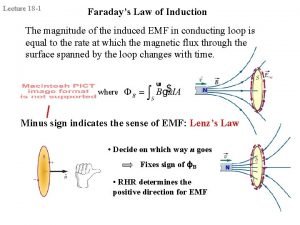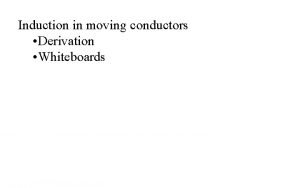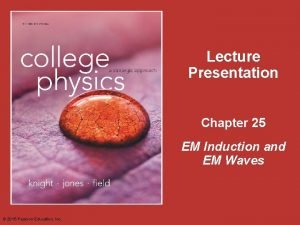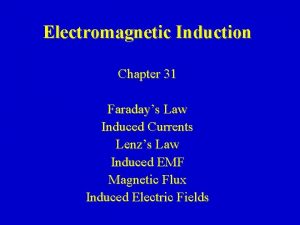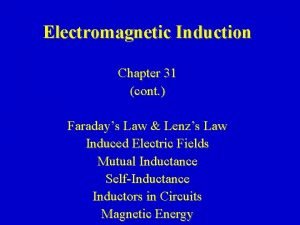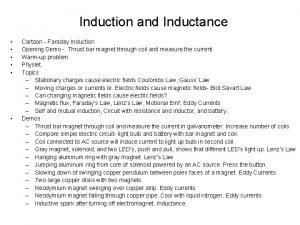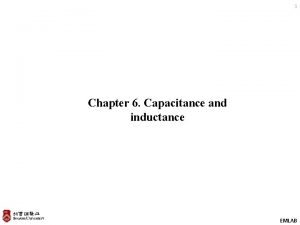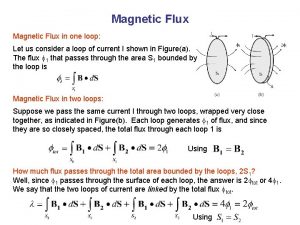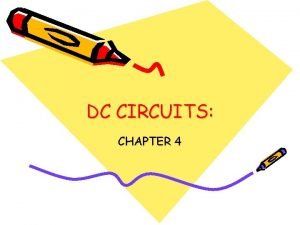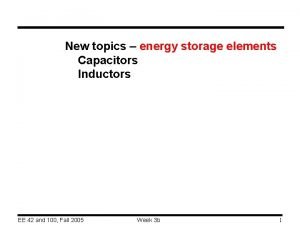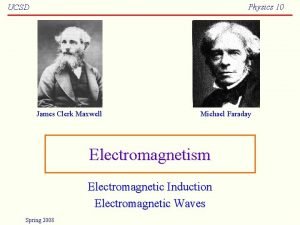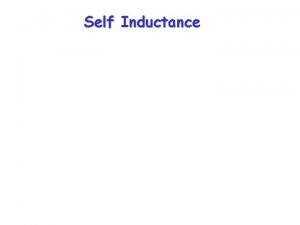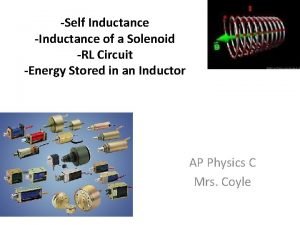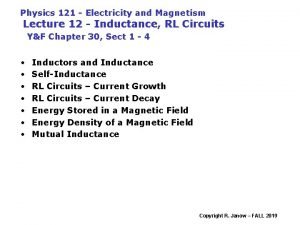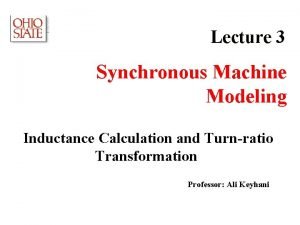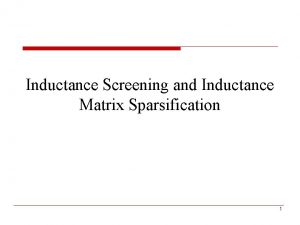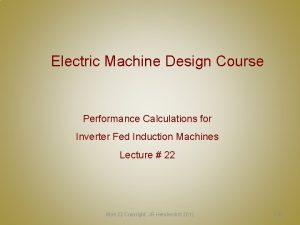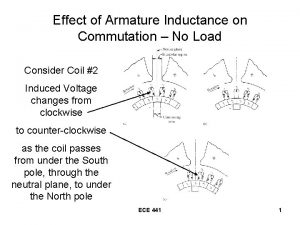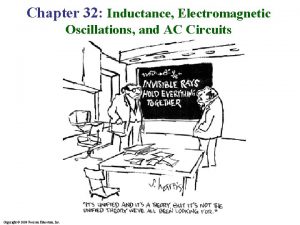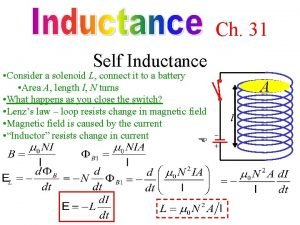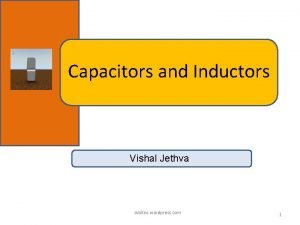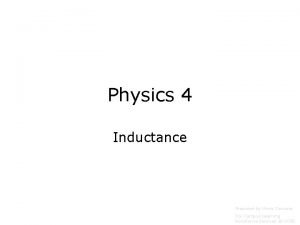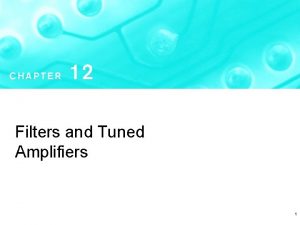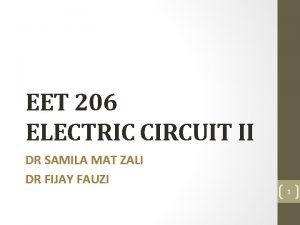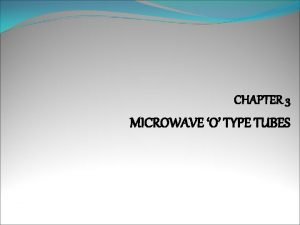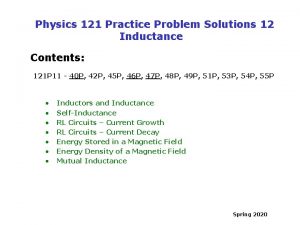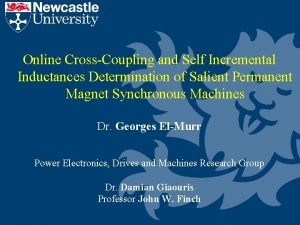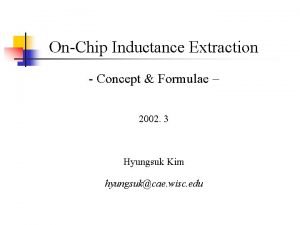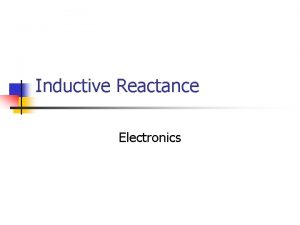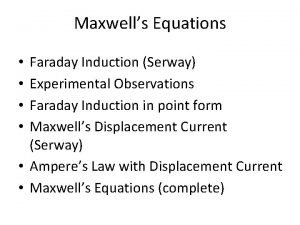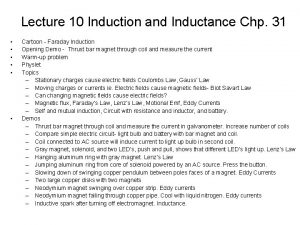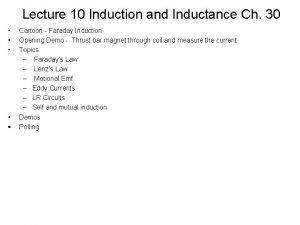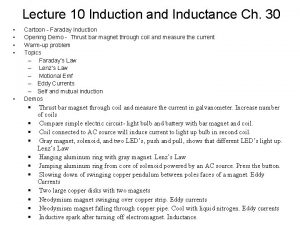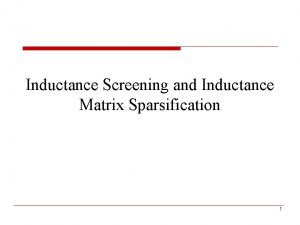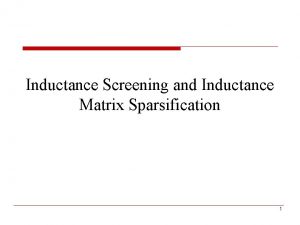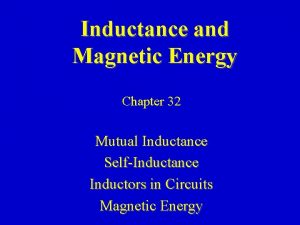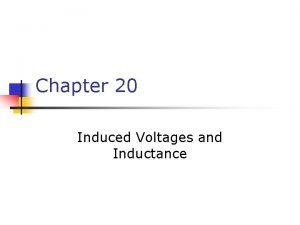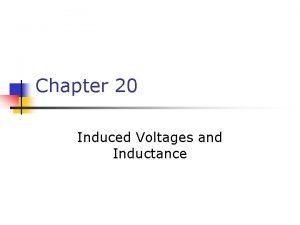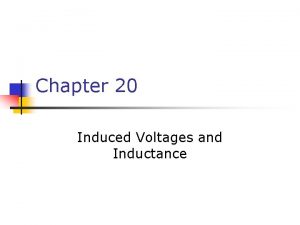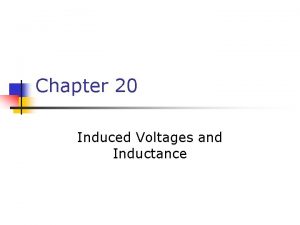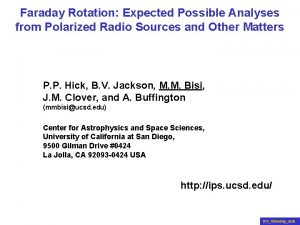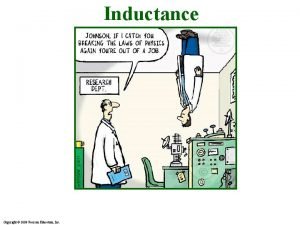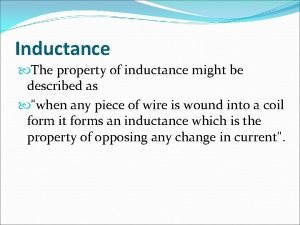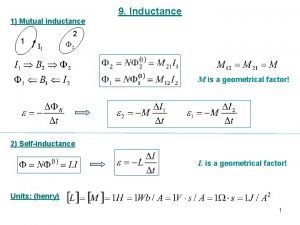Induction and Inductance Cartoon Faraday Induction Opening Demo
































- Slides: 32

Induction and Inductance • • • Cartoon - Faraday Induction Opening Demo - Thrust bar magnet through coil and measure the current Warm-up problem Physlet Topics – Stationary charges cause electric fields Coulombs Law, Gauss’ Law – Moving charges or currents ie. Electric fields cause magnetic fields- Biot Savart Law – Can changing magnetic fields cause electric fields? – Magnetic flux, Faraday’s Law, Lenz’s Law, Motional Emf, Eddy Currents – Self and mutual induction, Circuit with resistance and inductor, and battery. Demos – Thrust bar magnet through coil and measure the current in galvanometer. Increase number of coils – Compare simple electric circuit- light bulb and battery with bar magnet and coil. – Coil connected to AC source will induce current to light up bulb in second coil. – Gray magnet, solenoid, and two LED’s, push and pull, shows that different LED’s light up. Lenz’s Law – Hanging aluminum ring with gray magnet. Lenz’s Law – Jumping aluminum ring from core of solenoid powered by an AC source. Press the button. – Slowing down of swinging copper pendulum between poles faces of a magnet. Eddy Currents – Two large copper disks with two magnets – Neodymium magnet swinging over copper strip. Eddy currents – Neodymium magnet falling through copper pipe. Cool with liquid nitrogen. Eddy currents – Inductive spark after turning off electromagnet. Inductance.

Faraday’s Law • Discovered in 1830 s by Michael Faraday and Joseph Henry. Faraday was a poor boy and worked as a lab assistant and eventually took over the laboratory from his boss. • Faraday’s Law says that when magnetic flux changes in time, an Emf is induced in the environment which is not localized and also is non-conservative. • Lets look at various ways we can change the magnetic field with time and induce a current.

Magnetic flux First a Reminder in how to find the Magnetic flux across an area B Area A B B

Experiment 1 Thrusting a bar magnet through a loop of wire Magnetic flux Bar magnet Faraday’s Law at center Produced by current flowing in the wire. Lenz’s Law The current flows in the wire to produce a magnetic field that opposes the bar magnet. Note North poles repel each other.

Lenz’s Law: An induced current has a direction such that the magnetic field due to the current opposes the change in the magnetic flux that induces the current Question: What is the direction of the current induced in the ring given B increasing or decreasing? B due to induced current

Experiment 2 Throwing the switch In this case we throw the switch and as the current Increases from 0 to some value the magnetic field is changing with time and hence the flux through the second circuit is varying producing an induced Emf in the second circuit causing current to flow. Current in the second circuit only flows when the current in the first circuit changes with time. It stops flowing when the current in the first circuit is constant.

A simple example using a solenoid: Find the total magnetic flux through a solenoid with N = 600 turns, length = 0. 4 m, radius = 3 cm, and current = 10 A. . 4 oooo N=600 turns l=0. 4 m i = 10 A xxxx N = 600/0. 4 m =1500 turns/m N/L Flux increases like the square of the number of turns N for a solenoid. Note N 2 Increase B by using an iron core Weber = T m 2

Demo: Gray magnet, solenoid, LEDs magnet solenoid N <=> repel Push magnet in, one LED lights Pull magnet out, the other LED lights

Demo: Coil connected to AC source Light bulb connected to second coil (same as solenoid) Coil 2 Iron core (soft) means lots of inductance in wire so AC doesn’t heat up wire. Coil 1 Shows how flux changing through one coil due to alternating current induces current in second coil to light up bulb. Note no mechanical motion here.

Demo: Jumping aluminum ring from core of solenoid powered by an AC source. Press the button. • When I turn on the current, B is directed upward and momentarily the top of the iron is the North pole. If the ring surrounds the iron, then the flux in it increases in the upward direction. This change in flux increases a current in the ring so as to cause a downward B field opposing that due to the solenoid and iron. This means the ring acts like a magnet with a North pole downward and is repelled from the fixed coil. induced B field induced current • Try a square-shaped conductor • Try a ring with a gap in it • Try a ring cooled down to 78 K Repulsive force because 2 North poles N N Iron core (soft) Coil AC source

Experiment 3: Motional Emf Pull a conducting bar in a magnetic field. What happens to the free charges in the material? Moving bar of length L and width W entirely immersed in a magnetic field B. In this case an Emf is produced but no current flows B W + F v Work =qv. BL U=q emf =qv. BL L F = qv x B - v F Positive charges pile up at the top and negative charges at the bottom and no current flows, but an Emf is produced. Now let’s complete the circuit.

Motional Emf What force is required to keep current flowing in the circuit? Uniform magnetic field into the screen Pull the rectangular loop out of the magnetic field. A current i will be induced to flow in the loop in the direction shown. It produces a magnetic field that tries to increase the flux through the loop. Close up of the wire F=qv x B F 1=i. Lx. B + Wire FA A= area of magnetic field enclosed by the wire v

Motional Emf Continued F 1=i. Lx. B F 1 = Bi. L F 2 = Bix F 3 = - F 2 cancel Uniform magnetic field into the screen R is the resistance emf=i. R FA BLv = i. R This is the force you need to pull at to achieve constant r. F 1=FA

Motional emf : Work done How much work am I doing in pulling the circuit? W =Force x d Note that the magnetic field does do any work, What is the rate at which I am doing work? P=Fv What is thermal energy dissipated in the loop? Note that the rate at which I do work in pulling the loop appears totally as thermal energy. Circuit diagram for motional Emf. R is the resistance of the wire

Eddy Currents A solid piece of copper is moving out of a magnetic field. While it is moving out, an emf is generated forming millions of current loops as shown. Eddy currents are also formed in a copper pendulum allowed to swing across a magnet gap cutting magnetic lines of flux. Note that when the copper plate is immersed entirely in the magnet no eddy currents form.

Eddy Currents Demo • • • If a bulk conductor is present, we can induce currents to flow in the bulk conductor. Such currents are called eddy currents since they flow in circles. Demo: Try to place a copper sheet in between a pole faces of a magnet and/or try to pull it out. For example, in pulling it out, that part of the plate that was in the B field experiences a decrease in B and hence a change in magnetic flux in any loop drawn in that part of the copper. An emf is developed around such loops by Faraday's Law and in such a direction so as to oppose the change. Also try copper plate with slits. induced current Horseshoe x x magnet x x S B Copper pendulum B induced N Pull back pendulum and release. Pendulum dampens quickly. Force acts to slow down the pendulum. • Application: locomotive breaks operate on this principle. Magnetic dampening on balances. This is like a friction force that is linear with velocity. • Demo: Show neodymium magnet swinging over copper strip.

Demo: Copper pipe and neodymium-iron-born magnet Copper pipe S FD=Magnetic Drag Force ~ sm 2 d/a 4 m N W. M. Saslow Am. J. Phys. 60(8)1977 0 N N Two Norths repel so the magnet drops more slowly. FD d a N i Cool down the copper pipe with liquid nitrogen 28 K. This will reduce resistivity by about a factor of 5.

Demo: Hanging aluminum ring with gray magnet i N induced current N induced B field B repel • Note 2 N poles. Move magnet toward ring – they repel Current induced in ring so that the B field produced by the current in the ring opposes original B field. This means the ring current produces a N pole to push away the N pole of the permanent magnet. • When magnet is pulled back, it attracts the ring. i N S N B Current in ring is opposite to that above

The orange represents a magnetic field pointing into the screen and let say it is increasing at a steady rate like 100 gauss per sec. Then we put a copper ring In the field as shown below. What does Faradays Law say will happen? Current will flow in the ring. What will happen If there is no ring present? Now consider a hypothetical path Without any copper ring. There will be an induced Emf with electric field lines as shown above. In fact there will be many concentric circles everywhere in space. The red circuits have equal areas. Emf is the same in 1 and 2, less in 3 and 0 in 4. Note no current flows. Therefore, no thermal energy is dissipated

We can now say that a changing magnetic field produces an electric field not just an Emf. For example: Work done in moving a test charge around the loop in one revolution of induced Emf is Work=Emf*q 0 Work done is also Hence, Emf=2 pr. E or more generally for any path Faraday’s Law rewritten But we can not say because it would be 0. Electric potential has no meaning for induced electric fields

Characteristics of the induced emf • The induced emf is not localized such as at the terminals of a battery. • It is distributed throughout the circuit. • It can be thought of as an electric field circulating around a circuit such that the line integral of the electric field taken around a closed loop is the emf. • Since the line integral is not 0, the field is non-conservative. • There are no equipotential surfaces. • If there is a conductor present, a current will flow in the conductor. • If no conductor is present, there is no current flow, only emf. • Energy is dissipated only if charges are present.

Example: A magnetic field is to the board (screen) and uniform inside a radius R. What is the magnitude of the induced field at a distance r from the center? x x x B x r R x x x Field circulates around B field Notice that there is no wire or loop of wire. To find E use Faraday’s Law. E is parallel to dl

Example with numbers Suppose d. B/dt = - 1300 Gauss per sec and R= 8. 5 cm Find E at r = 5. 2 cm Find E at 12. 5 cm

What is an inductor? An inductor is a piece of wire twisted into a coil. It is also called a solenoid. If the current is constant in time, the inductor behaves like a wire with resistance. The current has to vary with time to make it behave as an inductor. When the current varies the magnetic field or flux varies with time inducing an Emf in the coil in a direction that opposes the original change. Suppose I move the switch to position a, then current starts to increase An Emf is induced to make current flow in the opposite diection. Now suppose I move the switch to position b

What is inductance? L What is a Henry? Start with Faraday’s Law (definition of inductance) (Henry) 1 H=1 T. m 2/A Amp (Henry/m) , Area l i B N turns A Numerical example – how many turns do you need to make a L = 4. 25 mh solenoid with l = 15 cm and diameter d = 4. 5 cm? Show demo: Inductive spark after turning off electromagnet

Numerical Example You have a 100 turn coil with radius 5 cm with a resistance of 10 . At what rate must a perpendicular B field change to produce a current of 4 A in the coil? Emf = IR = (4 A)(10 ) = 40 Volts B(t) N N = 100 turns R = 5 cm Coil resistance = 10 N coils so Multiply by N Because coils have resistance of 10 , induced current has a voltage drop so that emf = IR =

RL Circuits Close the switch to a. What happens? Write down the loop rule. Loop Rule: Sum of potentials =0 The potential can be defined across the inductor outside the region where the magnetic flux is changing. Solve this equation for the current i.

R 2000 4. 0 H 10 V Note t = L/R = 4/2000 = 0. 002 s, and

How is the magnetic energy stored in a solenoid or coil in our circuit? Start with Loop rule or Kirchoff’s Law I Solve it for e Multiply by i Rate at which energy is delivered to circuit from the battery Rate at which energy is lost in resistor Rate at which energy is stored in the magnetic field of the coil

What is the magnetic energy stored in a solenoid or coil For an inductor L l Area A The energy density formula is valid in general Now define the energy per unit volume

What is Mutual Inductance? M When two circuits are near one another and both have currents changing, they can induce emfs in each other. I 1 1 2 I 2 On circuit boards you have to be careful you do not put circuits near each other that have large mutual inductance. They have to be oriented carefully and even shielded.

 Faraday's law
Faraday's law Faraday's law of electromagnetic induction ppt
Faraday's law of electromagnetic induction ppt Faraday's law of electromagnetic induction ppt
Faraday's law of electromagnetic induction ppt Induced current
Induced current Faraday's law of electromagnetic induction
Faraday's law of electromagnetic induction Faraday cartoon
Faraday cartoon Inductance formula
Inductance formula How to find magnetic flux
How to find magnetic flux Introduction of capacitor and inductor
Introduction of capacitor and inductor Capacitor equation
Capacitor equation Relationship between capacitance and inductance
Relationship between capacitance and inductance Michael faraday and james clerk maxwell
Michael faraday and james clerk maxwell Magnetizing inductance
Magnetizing inductance Coefficient of self inductance
Coefficient of self inductance Inductance of solenoid formula
Inductance of solenoid formula Inductance emf formula
Inductance emf formula Magnetizing inductance
Magnetizing inductance Inverse of inductance
Inverse of inductance Imflux course
Imflux course Inductance energy
Inductance energy Polarity of interpoles in dc generator
Polarity of interpoles in dc generator Maxwell bridge is used to measure
Maxwell bridge is used to measure Inductance units
Inductance units Inductors in series
Inductors in series Finding equivalent inductance
Finding equivalent inductance What is inductance in physics
What is inductance in physics Tuned amplifier ppt
Tuned amplifier ppt Transformer dot convention
Transformer dot convention Difference between o type and m type tubes
Difference between o type and m type tubes Inductance practice problems
Inductance practice problems Incremental inductance
Incremental inductance Self inductance formula
Self inductance formula Si unit of inductive reactance
Si unit of inductive reactance
